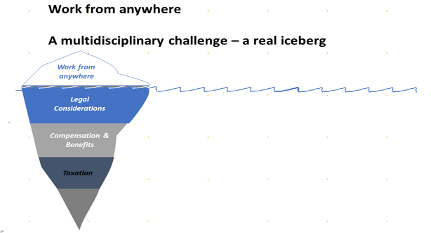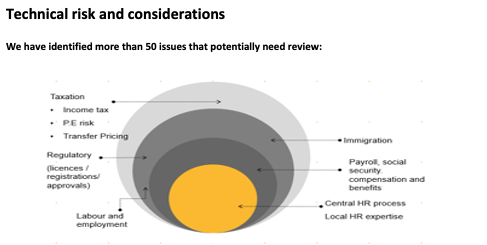
Work from anywhere

Work from anywhere - a multidisciplinary challenge
57% of all workers in 208,000 people strong multi-country survey said they would work remotely for an employer with no local physical in-country presence. In some countries, 80%+ find this appealing (Mexico + Brazil). *
But are you aware of all the challenges and risks that may arise for the employee and your company?

*Decoding Global Talent, Onsite and Virtual | BCG
https://www.bcg.com/en-gb/publications/2021/virtual-mobility-in-the-global-workforce
The COVID-19 pandemic has fundamentally changed the future of work. Having a presence in office buildings has quickly been replaced by solutions such as “working from home”, and could be effectively replaced by “work from anywhere” (WFA) – the expectations are changing. Work from anywhere is now embedded into an increasing number of Employee Value Propositions - it is now an employee benefit. An expectation in certain sectors amongst current staff and new recruits, playing an important role in retaining and recruiting within companies. Nethertheless, a company cannot just let employees work wherever they want, unless they are ready and willing to absorb potential additional costs and risks.
What are we seeing in the market?
- Workforce has shape-shifted during the pandemic
Expatriates, employees, closed borders have created many, many cases. Cross-border remote working was created by necessity.
- Talent trends
Integrated into workplace agility, total reward work from anywhere now is a valuable employee benefit, even an expectation in certain industries and roles. As the global talent war heats up this agility is now a competitive part of the work offer some countries now are targeting these remote workers – so-called remote worker visas. Aruba, Barbados, Dubai, Bermuda are some examples and many more. Tulsa in the US is a city doing the same.
- Return to office conversations are a catalyst for uncovering cases
A number of employees went cross-border remote during the pandemic. As economies have opened up and return to work conversations have progressed cross-border remote working is now happening by design. Certain countries and cities actively are targeting to hire remote workers.
- Picture of different types of responses getting clearer
Companies offering a WFA model want to proactively create the flexibility employees want today and remain competitive in the labor market. At the same time, they may be setting themselves up for unexpected and significant costs and challenges. This means responses such as detailed case assessments, time-barred in-country presence policies – country-specific or global approaches. But keep in mind, once you've offered a WFA model to employees, it is going to be hard to close the barn doors behind the horse.

A growing market issue
CROWE supports clients and targets with the following services created
- Payroll
- Payroll and tax registrations
- Possible entity set ups
- Mobility and social security compliance and advisory
- P.E risk assessments for corporate tax (even sales and VAT)
- Training and education on the issue
- There will be more.
Get the advice to be compliant and what you need to implement, increase, and lead your business:
For more information, please contact our Global Mobility Specialists:
|
Simone Jäkel |
German Vega |
Gabriel Nava |
Autor